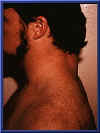 |
 | | Today is ...and it's about time there was some support for Cushing's! |

|
Buffalo Hump
 The Buffalo Hump is
an accumulation of fat on the back of the neck and upper back. This
condition can occur with oversecretion of cortisone by the adrenal gland, a condition called Cushing's syndrome. The Buffalo Hump is
an accumulation of fat on the back of the neck and upper back. This
condition can occur with oversecretion of cortisone by the adrenal gland, a condition called Cushing's syndrome.
A buffalo hump by itself is not
diagnostic of any one condition. It must be considered in light of other signs,
symptoms, and tests.
Click on the thumbnail image for a larger view.
Common causes:
 | extended use of some steroids (glucocorticoids such as prednisone, cortisone, and hydrocortisone) |
 | extreme obesity |
 | hypercortisolism (caused by Cushing's
syndrome) |
 | Note: There may be other causes of a hump behind the shoulders. This list is not all inclusive, and the causes are not presented in order of likelihood. The causes of this symptom can include unlikely diseases and medications. Furthermore, the causes may vary based on age and gender of the affected person, as well as on the specific characteristics of the symptom such as time course, aggravating factors, relieving factors, and associated complaints. |
Home care:
 | If a buffalo hump is due to medication such as steroid use,
ask your health care provider about discontinuing, changing, or reducing the medication dosage. |
 | NEVER CHANGE MEDICATION WITHOUT CONSULTING YOUR HEALTH CARE PROVIDER. |
 | For extreme obesity, diet and exercise can help you to lose weight. |
 | Call your health care provider if there is an unexplained buffalo hump. |
What to expect at your health care provider's office:
 | The medical history will be obtained and a physical examination performed. |
 | Medical history questions documenting your symptom in detail may include:
 | What medications are you taking? |
 | Are you overweight? |
 | Are you female? |
 | How old are you? |
 | Have you been evaluated for osteoporosis? |
 | What other symptoms are present? |
|
 | Diagnostic tests that may be performed include:
 | arteriography |
 | blood tests (such as CBC, or blood differential) |
 | urine tests (such as urinalysis) |
 | bronchography |
 | CT scan of the skull |
 | CT scan of the abdomen and adrenal glands |
 | MRI of the skull |
 | endocrine studies |
 | cortisol level |
 | dexamethasone suppression test |
 | ultrasonography |
 | visual field testing |
 | X-rays of the chest |
|
After seeing your health care provider:
If a diagnosis was made by your health care provider related to a buffalo hump, you may want to note that diagnosis in
your personal medical record.
Cushings-Help.com shall not be held liable for any claim or right to recover damages, including, but not limited to, loss of profit, business, other incidental consequential damages, or other similar claims, even if Cushings-Help.com has been specifically advised of the possibility of such damages.
| |
|


